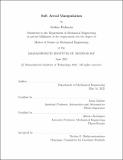Soft Aerial Manipulation
Author(s)
Fishman, Joshua
DownloadThesis PDF (5.788Mb)
Advisor
Carlone, Luca
Rodriguez, Alberto
Terms of use
Metadata
Show full item recordAbstract
This thesis explores the theory and implementation of a soft drone, consisting of a quadrotor and a tendon-actuated soft gripper, which for the first time fully exploits the advantages of softness in aerial manipulation. Manipulation and grasping with unmanned aerial vehicles (UAVs) currently require accurate positioning and are often executed at reduced speed to ensure successful grasps. This is because modern aerial manipulation platforms employ rigid manipulators with few degrees of freedom, limiting their capability to compensate for disturbances caused by the vehicle positioning errors and maintain stability despite external contact forces. Biological systems, on the other hand, exploit softness to overcome similar limitations, and leverage compliance to enable aggressive grasping. To the best of our knowledge, ours is the first work at the intersection between soft manipulation and UAV control.
We present a control and planning approach for the soft drone (quadrotor and soft gripper), decoupling the two subsystems and employing (i) a geometric controller and a minimum-snap trajectory optimization for the quadrotor (rigid) base, and (ii) a quasi-static finite element model and control-space interpolation for the soft gripper. We prove that the geometric controller asymptotically stabilizes the quadrotor velocity and attitude despite the addition of the soft load. Next, we describe our soft drone prototype, including electro-mechanical design, software infrastructure, and fabrication. Finally, we evaluate the proposed system in a realistic soft dynamics simulator (SOFA) and in real tests, and show that: (i) the geometric controller is fairly insensitive to the soft payload, (ii) in simulation, our soft drone outperforms more rigid alternatives, (iii) the platform can reliably grasp unknown objects despite inaccurate positioning and initial conditions, both in simulation and in real testing. Our soft drone can grasp at up to 2 m/s in simulation and consistently grasps at 0.2 m/s in real tests (91.7% success rate).
Video attachments:
https://youtu.be/NNpQxP0SPFk
https://youtu.be/mqbj8mEyCdk
Date issued
2021-06Department
Massachusetts Institute of Technology. Department of Mechanical EngineeringPublisher
Massachusetts Institute of Technology